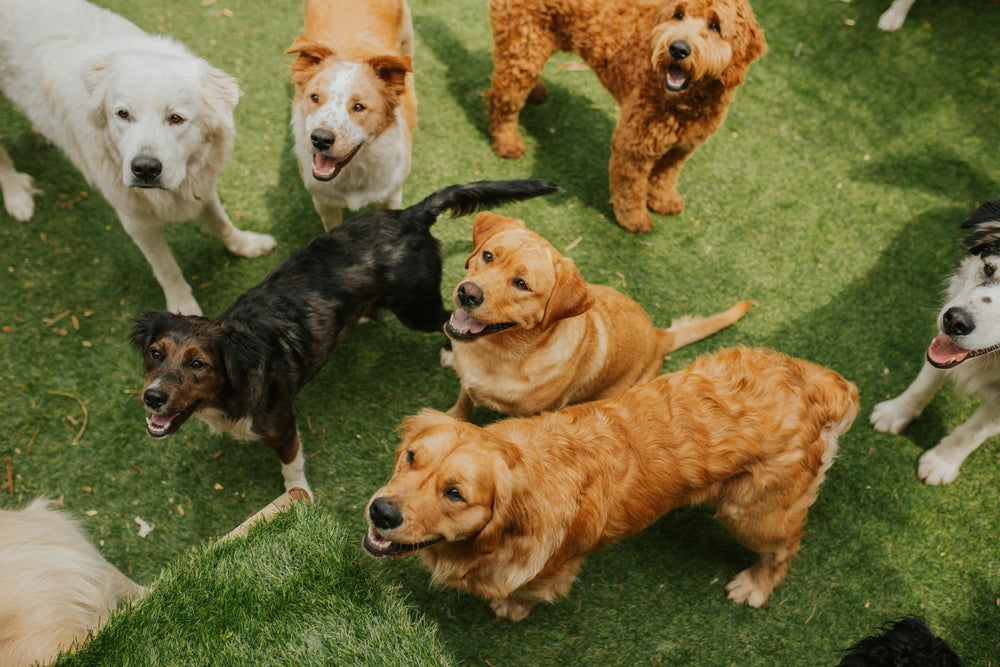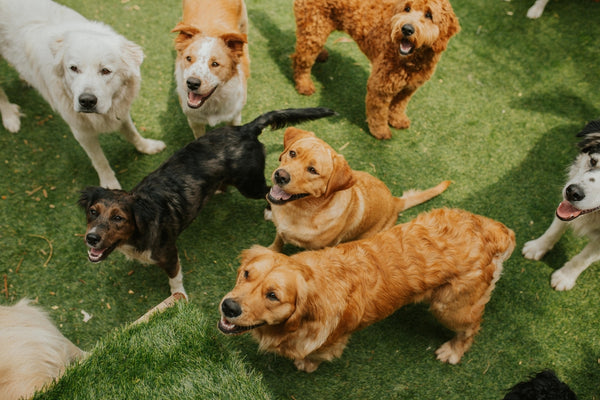Dog Park Dilemmas: Etiquette Tips for a Pawsome Playdate
Posted by Jackie Ly on Feb 16, 2024

Table of Contents
-
Common Dilemmas at Dog Parks
-
Dog Park Etiquette Tips: BEFORE going to a dog park
-
Dog Park Etiquette Tips: when AT a dog park
-
Bottom Line
Beautiful landscaping, wide, open area, and lots of happy wagging tails, dog parks are a fantastic amenity that are growing increasingly popular in towns and cities. It’s a place where you and your dog can socialise and have fun with other dog owners and dogs within your area.
However, sharing a public space along with many canines comes with risks and dilemmas. Some dogs are not social or are not trained yet. Lack of proper controls or systems to protect smaller and shyer dogs from larger, more outgoing ones, and sometimes, dog owners just act badly in these spaces.
Dog owners should be the ones keeping dog parks safe, clean, and welcoming for everyone, so in here, we equip you with some pawsome etiquette tips for a fun and responsible dog park adventure!
Common Dilemmas at Dog Parks
Here are the most common issues experienced at dog parks:
- Aggressive dogs
- Lack of proper controls or systems
- Owners don’t pay attention to their animals or fully understand their behaviour
- Inappropriate use of toys or treats
- Size and breed differences
- Owners not cleaning up after their pets
- Resource guarding between dogs
- Negative interactions if a dog is on a leash in an area with off leash dogs
Almost all of these dilemmas can be prevented when dog owners properly train their dog first, and prepare well before going to a dog park. Below, we listed helpful etiquette tips you should follow to ensure that not only you and your dog, but all people and dogs at dog parks have a good time.
Dog Park Etiquette Tips: Before Going to a Dog Park
Be honest with yourself about your dog’s temperament
The first step in preparing your dog to go to a dog park is being honest with yourself. Every dog has a unique temperament, and it's critical to understand your dog's before taking them to the dog park.
Do they feel frightened with huge groups of unfamiliar dogs? Are they a runner who must be in a fenced-in park? How do they react to larger dogs compared to smaller dogs?
Just because they are calm at home doesn't mean that they will be in an uncontrolled situation. If your pet becomes overwhelmed or violent, it does not necessarily reflect on you as the owner or on them. It's fine if they're the sweetest dog in the world and just don't like parks. Don't force them to leave or disregard their concerns.
Make sure they have already experienced socialising with other breeds and sizes
Ideally, before visiting a dog park, your dog should have taken part in doggy play groups or spent a significant amount of time around a variety of dog breeds and sizes. Dog parks are highly stimulating places with many new sights, smells, and pals to meet, so your dog must be well-socialised and relaxed in the presence of other dogs.
If you know your dog has behavioural issues, don't use this as a chance to socialise them. They will not get used to it, learn to play nice, or figure it out for themselves. Dogs who struggle with other animals require thorough, expert behavioural training. You can't expect them to immediately know how to act in these difficult situations.
Make sure they are vaccinated and in good health
Before going to a dog park, make sure your dog is vaccinated, receives regular preventative care and is in good health. This is particularly important because dogs often interact with one another at dog parks, and there is an increased possibility of disease or virus transmission through play, sharing toys, or shared water bowls.
It goes without saying that a Rabies vaccination is required, but other vaccinations like Parvo, Distemper, and Adenovirus are also required while visiting a dog park. Bordetella, sometimes known as kennel cough, may be recommended in addition to flea and tick treatment.
Fully vaccinated dogs not only keep other dogs safe, but also people.
Pick the right dog park: Go to the park by yourself and look at the park’s other dog regulars
To know which park is the best for your dog, go to the park by yourself and examine the place. Check if it is clean and doesn't have problems like mud, too much dog poop, a broken fence, or other issues. Inquire about what time of day it is crowded and less crowded. Observe the regulars and their behaviours.
You can also look online or ask friends, neighbours, or family for more information about dog parks in your area. Since weekends and nights are the busiest times for dog parks, you may want to plan your first visit at an off-peak time.
Big dog or small dogs
Many dog parks offer separate areas for large and small dogs, and it is essential to follow this rule. Small dogs are normally welcome in the large dog park (at your own risk), but larger canines should not enter the small dog park.
A small dog park is designed for dogs weighing 30 pounds or less, and having huge dogs around can stress out the smaller dogs and potentially be harmful.
Fenced-In Parks vs Open Parks
Choosing between fenced-in and open or off-leash parks depends on your dog's off-leash attitude and your relationship with them. While some dogs shine on large, wide-open spaces–playing frisbee and running–that’s not the case for other dogs.
Taking your dog off-leash to an unfenced park increases the risk that they will run off and get lost. If your dog has a tendency to run away, isn't fully trained yet, or is new to the family and hasn't formed a strong relationship with you yet, it is recommended to visit a fenced park.
However, if you and your dog already have an excellent relationship, they stay close to you when off-leash, and are trained to obey commands, open or off-leash dog parks can be a wonderful place for them to explore and get some physical activity. Just make sure they are microchipped or wearing a collar with updated identification tags.
Train your dog to have a reliable recall
A dog simply knowing their name is not the same as having a good recall. Recall, or teaching your dog to return when called, is one of the most critical skills you can teach. Recall can be taught at any stage of a dog's life using consistent, positive training techniques.
A good recall is a must since there is always a chance that your dog will escape from their leash, or get distracted when they are off-leash and follow something. This could lead to them running across the road, getting lost, or getting into a fight with another dog.
When they have good recall, they will come back to you when you say your command words–the most simple one is calling their name followed by ‘Come!’ or ‘Here!’.
Learn about dog’s body language and warning signs
You can never read your dog’s mood and behaviours accurately, especially when they’re in a new and highly stimulating environment like dog parks. But still, knowing their body language and their behavioural warning signs is a big help in determining whether they’re having a fun time or not.
Knowing your dog's warning signs enables you to act faster if they become reactive. Lip-licking, yawning, pinned back ears, walking low to the ground, a stiff body attitude, and a low or tucked tail can be signs of anxiety or discomfort, among other things.
Aggression tends to be more noticeable. They include growling, snapping, snarling, bared teeth, and lunging. It is important to de-escalate these situations as soon as possible.
Bring your own water/water bowl
Always keep your dog hydrated at the dog park to prevent heatstroke, upset stomachs, and dry noses. While most dog parks feature water bowls, seeing dozens of dogs drink from the same bowl every day raises the danger of viruses and bacteria spreading.
Bring your own water and travel bowl to the park to prevent any bacteria spreading and to ensure that your fur baby drinks fresh, clean water.
Leave toys at home (to avoid unwanted fights)
The last thing you want is for another dog to be interested in your dog's toys. This may cause a commotion when it could have been avoided altogether. It is recommended to leave fetch toys, noisy toys, and toys that may have had treats placed inside or on them at some point–as other dogs can pick up and follow the smell.
Dog Park Etiquette Tips: When at the dog park
Keep your dog on-leash
Learn about the park’s rules on leashes when you scout the park. Some parks want leashes off because there are dogs that are triggered by leashes, and some want dogs on-leash to ensure their safety and the calm of the place.
In a fenced park, not only should you keep your dog on a leash for safety reasons (you don't want them running out onto the road), but it's also good dog manners.
In an off-leash park, you may want to keep them on-leash for the first few minutes after your arrival. You can control their initial introduction to the park and other dogs, and stop them bolting straight over to an unfamiliar animal.
Then, you can remove your dog’s leash before they join the group. It’s harder for dogs to use body language to communicate while on-leash. Also, playing and running around with a leash attached creates tripping, tangling, and choking hazards.
It all depends on the park’s rules, so make sure you know that prior to your visit.
Keep an eye on your dog to prevent any unruly behaviour
Always look after your dog. Many negative interactions between dogs could be prevented if owners were attentive and responsible for their pets. Even if they are regular, you still have to pay close attention. Don't assume others have control of the situation.
If you decide to take your dog to the park, learn the etiquette and prepare yourself and your dog beforehand.
Ask before giving other dogs treats
Giving goodies is understandably a gesture of love for many people, but it is hard to tell if a dog has health problems or is on a limited diet. Most dogs will happily eat anything, even if it is dangerous for them, so always check with their owner before giving them treats.
Clean up after yourself and your dog
Clean up after your dog at the park to keep it safe for everyone. Bring poop bags, pick up your dog's mess, and throw it in the nearest trash can. If you have treats, food, or toys, throw them away or take them home to prevent other dogs from eating the wrong things or getting hurt.
Respect others’ wishes
A dog park's safety depends on dog owners showing mutual respect and communicating effectively. If someone mentions their dog is uncomfortable around new faces, they might request that other dogs keep a bit of distance. Don't take it personally and grant their request.
Regardless of how well-behaved your dog is, understanding and respecting the concerns of others helps prevent potential conflicts and maintains a positive experience for everyone at the park.
Bottom Line
Trying out new things is both a fun adventure for you and your dog, and if a dog park is on your list, why not! Just make sure that you will come prepared, you know the rules and guidelines, and you know very well that your dog can handle social situations. These things ensure that your dog will have an enjoyable experience, going home happily wagging their tails and excited for the next adventure!
